Multiple Disciplines
Interdisciplinary approach
An interdisciplinary approach across a broad array of sciences, especially in the geological and biological sciences, is applied to better understand the complex interconnection of Critical Zone processes. Examples include pedology, hydrology, geology, geophysics, ecology, biogeochemistry, and geomorphology.
Multiple Disciplines, Multiple Approaches
Meeting the goals of Critical Zone science requires researchers with deep disciplinary knowledge as well as collaboration and integration across multiple disciplines.
-
Disciplinary - Specialists are vital members of our teams since progress in Critical Zone Science requires deep knowledge of many portions of the combined physical, chemical, and biological system.
- Multidisciplinary - Close cooperation between specialists, each employing their own approach, helps to better understand interconnected Critical Zone processes.
- Interdisciplinary - Concerted integration across disciplinary boundaries has been invaluable for solving questions that require a holistic approach.
Close collaboration has required the development of infrastructure and protocols that allow measurements to be directly compared across CZOs. See Infrastructure > A Common Approach
CZO Working Groups
Each observatory has working groups aligned along disciplines and/or research foci. Furthermore, cross-CZO working groups aim to develop and advance cross-site science at all the CZOs.
Discipline Tags
View people, news, events, publications, etc aggregated by discipline tag within and across CZOs. Most content is interdisciplinary and tagged with 2-3 disciplines.
Biogeochemistry
e.g. carbon, nitrogen
Biology / Ecology
e.g. vegetation, ecosystems
Biology / Molecular
e.g. microbes, DNA
Climatology / Meteorology
e.g. weather, air pressure
Data Management / CyberInfrastructure
e.g. databases, Q/A, portals
Engineering / Method Development
e.g. wireless networks
Geochemistry / Mineralogy
e.g. elements, isotopes
Geology / Chronology
e.g. bedrock, age dating
Geomorphology
e.g. landscape, sediment transport
Geophysics
e.g. seismic, radar, resistivity
GIS / Remote Sensing
e.g. maps, elevation, LiDAR
Hydrology
e.g. discharge, groundwater
Modeling / Computational Science
e.g. models, algorithms
Outreach / Education Research
e.g. assessment, interviews
Social Science
e.g. land-use history
Soil Science / Pedology
e.g. genesis, classification
Water Chemistry
e.g. surface water, solutes
Explore Further

